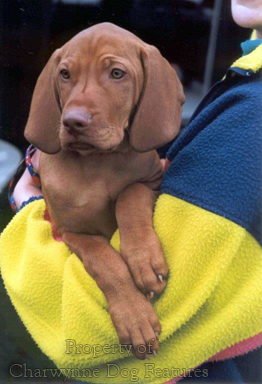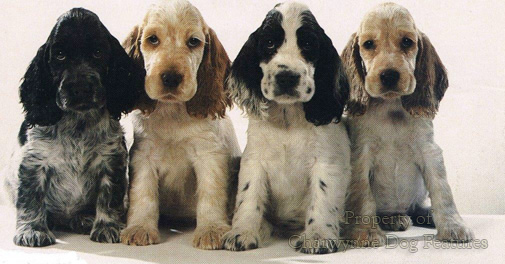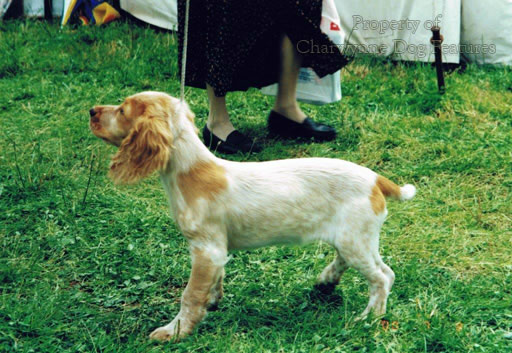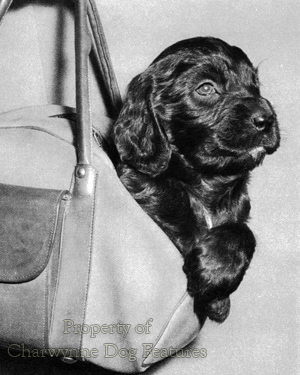729 CREATING CANINE COMPANIONS
CREATING CANINE COMPANION
by David Hancock
 Every survey of homeless dogs tell us that the biggest single cause of dogs ending up in need of a home is temperament. This isn't always rooted in dodgy temperament but is often created by inadequate socialising when the dog is young and most impressionable. Dogs are nearly always what we make them. But when we breed most pure-bred dogs for looks ahead of anything else, is that the best criterion for an animal destined to be purely a companion? Of course no sane breeder ignores temperament in his output but it is definitely not given the top priority it merits. Dogs bred to be ‘game’ or to be hyperactive don’t make the best companion dogs.
Every survey of homeless dogs tell us that the biggest single cause of dogs ending up in need of a home is temperament. This isn't always rooted in dodgy temperament but is often created by inadequate socialising when the dog is young and most impressionable. Dogs are nearly always what we make them. But when we breed most pure-bred dogs for looks ahead of anything else, is that the best criterion for an animal destined to be purely a companion? Of course no sane breeder ignores temperament in his output but it is definitely not given the top priority it merits. Dogs bred to be ‘game’ or to be hyperactive don’t make the best companion dogs.
We breed exceptionally hairy dogs; ask the staff in welfare kennels to describe the condition of such a dog when it comes into their hands! We breed highly-strung hyper-active dogs, for ever on the qui-vive in the sporting field and in the pastures. Ask kennel staff how difficult it is to find a home for such a dog. We breed dogs with faulty genes, destined to live handicapped lives - or short ones. We will never breed a genetically-perfect dog but there are ways of minimising such a risk. We breed too many dogs; it is just too easy to produce a litter, to sell unsound or poorly-socialised pups and to make money from such a venture. It is easy to condemn a breeder who hands over 160 retrievers to the RSPCA and then retains forty breeding bitches. But just try breaching her 'human rights' by banning such activity!
We are, as a nation, however, unconcerned about the fate of around 20,000 packhounds, out of a deep-felt concern for foxes. These hounds have been painstakingly socialised and made steady to livestock. Hunt staff and puppy-walkers ensure that hounds are geared for a world beyond hunting; how many commercial breeders do that? It is against our Anglo-Saxon instincts to tolerate over-regulation, but if dogs in rescue could be allowed a view, they might favour tighter regulations over their breeding. Is the human viewpoint the only one to be considered? A deep-felt concern for dogs is less likely to lead to an Act of Parliament to protect their best interests. Which animal is in the greater need, dog or fox? I no longer support the view that each and every one of us should be free to breed as many dogs as we like and to any standard, as dog-breeders can now. Dogs have long needed protection from humans and that need has not lessened in the twenty first century.
Our Kennel Club has never been slow toregister newly-designed dog breeds, as the Cesky Terrier, the Russian Black Terrier and the Eurasier demonstrate. Kennel club recognition may not be a requirement for dogs not intended to be shown or bred from. But at some stage soon we are going to have to look at the way the domestic dog is bred, the numbers being bred and how the desire to have a companion dog is being met. It is not reasonable to expect animal charities or breed rescue to carry the increasing problem of unwanted dogs; it is not acceptable surely for a nation of dog-lovers to continue to treat dogs so shabbily. The care of dogs in the coming century has to be planned not left entirely to human whim - that is, until such time as direct cruelty can be proved. Such an approach is time-expired. 
One day soon, in the world of the purebred dog, kennel clubs will be persuaded to use the power of being the sole body registering progeny, to minimize the breeding of genetically faulty dogs, physically impaired dogs and just too many dogs. One day, not soon enough, we will breed dogs specifically as companions, with the size, coat texture, character and, most important of all, the temperament, to meet owner-needs rather than breeder-needs. Is it fair on dogs for the Dulux paint advertisement to 'sell' so many Old English Sheepdogs to unsuitable homes that 200 a month end up in rescue? Is it fair on dogs for the marketing of toilet rolls to lead to over 40,000 Labradors being bred each year? It is hardly surprising if 160 are handed over to the RSPCA from one breeder alone. We may not be able to control the marketing men. But we could take more steps to prevent reckless breeding. We could also, as marketing men unfailingly do, create a market - for dogs more suitable as pets than so many pure breeds are.
Not so long ago, I came across, in the morning, a still young heavily-coated likeable Sheltie which was going blind. His owners were finding the heavy coat difficult to manage and the approaching blindness heart-breaking. It wasn't much fun for the dog either. Its litter-mates had the same distressing eye condition too. In the afternoon, I visited the well-known breeder-exhibitor of dogs and horses, Betty Judge, to see her newly-imported dogs. In the yard were a dozen Portuguese Podengos, of the small variety. They were utterly charming, alert, lively but not manic, with weatherproof but easily managed coats, small in stature but not tiny and with quite superb temperament. For many many people they would make perfect companion dogs, but who can afford to market such a product to the public at large?
Whenever I see the admirable Manchester Terrier at shows I can never fathom out why they aren't highly popular as pets. They have trouble-free coats, handy size, equable temperament and great charm. I mention them to people asking me the dreaded question: What dog should I get? They respond with the predictable comment: What's a Manchester Terrier? Promoting a breed is not without its dangers, as the Dobermann, Rottweiler and, more recently, the Neapolitan Mastiff fraternities have discovered. But even to minimize mis-matches between owner and breed, some promotion in the guise of education has to be attempted. The Plummer Terrier is a quite admirable breed, but not an ideal town pet. It was bred to be a superlative vermin-killer by a gifted breeder. Its Beagle blood can make it a wanderer; its Pit Bull Terrier blood can make it too feisty. Owners unaware of its breed-ingredients can take this essentially working terrier to quite the wrong environment.
The Sporting Lucas Terrier, also created by a gifted breeder, seems to fit seamlessly into any household, rural or urban. Unlike many of the pups from working terrier stock, advertised weekly in the sporting press, this emerging breed is very adaptable, willing ratters but eager sofa-dwellers too. They have sufficient perky charm to delight anyone but are little known. This is a terrier breed not registered with the KC but one free of the many skin problems which seem to afflict a number of pedigree terrier breeds. Some of the healthiest and soundest dogs I see, especially at country shows, are neither registered with the KC nor pure-bred. Cross-bred dogs possess hybrid vigour, which they may not pass on, but certainly benefit from. Sickly pure-bred dogs are not ideal pets for those with a limited disposable income.
I think it is fair to say that we breed far too many sickly dogs; we breed far too few dogs specifically to be companion dogs, despite that market being the greatest. A show breeder, aiming to produce handsome dogs which conform closely to the word-picture set out for the breed, doesn't put character ahead of other assets and all too often gives temperament a lower priority than it deserves. When I mention the importance of a stable predictable equable temperament to breeders of big strapping dogs like Bullmastiffs, Dogues de Bordeaux, Neapolitan Mastiffs and Canary Dogs, both here and abroad, they agree, but then breed from the sharp tempered champion, rather than the calmer less aggressive runner-up. But they usually sell most of their pups to pet homes. American Bulldogs are not always given a good press, but when I have judged them, their temperament has been impressive.
When judging Victorian Bulldogs, it always strikes me how companionable they are, sound physically and full of character. They are bred to a standard but their owners are keener to own, not perfect dogs, but dogs with engaging ways and, despite their not exactly pretty faces, a definite appeal. We all like a handsome dog but not all of us like a dog bred to a harmful design, with physical exaggerations which afflict the dog. I have heard KC-recognised breed fanciers describe emergent breeds such as the Victorian Bulldog, the Plummer Terrier and the Sporting Lucas Terrier rather distainfully as 'cross-breds', as though that was some kind of demerit. I see far less sound dogs in KC-sanctioned show rings; the possession of a pedigree is far from being an automatic certificate of merit.
It is worth keeping in mind how the Cavalier King Charles Spaniel came to be re-created. A wealthy American fancier, distraught over the muzzleless, bulging-eyed specimens of King Charles Spaniel masquerading under that title, offered inducement for the re-creation of a real King Charles Spaniel type. The Cavalier version was developed and has never looked back. It shows that when a breed loses type, one strong-minded committed fancier can change things. Sometimes cross-breeding has to be involved in such change. But the outcome produces a more desired companion dog too; in 2009, over 8,800 Cavaliers were newly registered, against only 150 King Charles Spaniels. Muzzleless Bulldogs may one day be similarly replaced by the healthier Victorian variety. If you want a Bulldog, why not get one that looks like its real ancestors?
Forty years ago, the distinguished veterinary psychologist, MW Fox was writing: "The breed of dog that a person owns may be a projection of deeper needs and identifications. An insecure or paranoid person may want a powerful guard dog. Another person who is attempting to live up to an ego image of grace and agility may keep an Afghan Hound or a Saluki." The choice should surely rely not on the owner's personality but that of the breed. At the same time Cheshire vet Joan Joshua was writing: "People choose breeds without any thought of their natural working tendencies. Working sheepdogs are popular pets, yet how many appear in veterinary surgeries as pathetic and incurable neurotics because their owners have failed to meet their need to be disciplined, submissive working dogs?"
MW Fox went on to write: "It is important that a potential owner be advised as to the suitability of a certain breed that he feels that he would like. Such 'adoption counselling' would be a great service to the owner." I believe it would be a far greater service to the dog; it would surely reduce the numbers of unwanted dogs in rescue and welfare kennels at this time. But if someone seeking a companion dog contacts a breed club, I doubt if their needs and circumstances are analysed. The Kennel Club too only supplies a list of breeders in a stated breed. Who is truly going to provide prospective dog-owners with the most valuable advice of all - the best breed for the need?
All over the country, in rescue kennels and canine welfare centres, there are thousands of dogs longing to be given a real home. Whenever I visit the admirable Blue Cross kennels near me, it is full of lurchers. Lurchers don't always make good house dogs; they are not always cat-friendly. I know of one breeder producing a thousand lurchers a year. He is not breeding companion dogs. One of my neighbours, elderly and quite infirm, who walks with a stick and is physically tiny, was allocated a hyper-active highly-strung Border Collie by a local animal sanctuary. To her great distress the match was, not surprisingly, not a success. The wretched dog was once again returned to the sanctuary to await their next re-homing decision. Such a dog is not an ideal companion dog and is entirely unsuitable for an immobile old lady. All over the country too, in breed-rescue kennels as well as those run by national charities, there are far too many dogs seeking a permanent home, far too many pedigree dogs without a home. We are mistreating dogs simply by breeding too many.